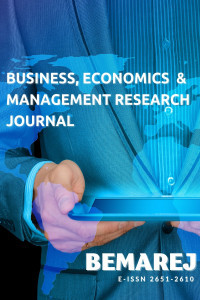Sürdürülebilir insan kaynakları yönetimi için çalışan deneyimi uygulamaları
Deneyim, Yararlılık, Üretkenlik, Etkileşim, Örgütsel Tasarım, Sürdürülebilir İnsan Kaynakları Yönetimi
Employee experience practices for sustainable human resources management
Experience, Utility, Productivity, Engagement, Organizational Design, Sustainable Human Resources Management,
___
- Bersin, J. (2016, Temmuz 19). The HR Software market reinvents itself. https://www.peoplemattersglobal.com/blog/technology/the-hr-software-market-reinvents-itself-16121
- Bersin, J., Solow, M. & Wakefield, N. (2016). Design thinking: Crafting the employee experience. https://dupress.deloitte.com/dup-us-en/focus/human-capitaltrends/2016/employee-experience-management-design-thinking.html
- Brown, T. (2008). Design thinking. Harvard business review, 86(6), 84.
- Cohen, P. (2015). One company’s new minimum wage: $70,000 a year. The New York Times, 13. http://www.nytimes.com/2015/04/14/business/owner-of-gravity-payments-a-credit-card-processor-is-setting-a-new-minimum-wage-70000-a-year.html?_r=0
- Copeland, C. (2015). IRA asset allocation, 2011. EBRI Notes, 36(9), 1-28.
- Deloitte. (2016). Deloitte’nin küresel insan sermayesi akımları. https://www2.deloitte.com/us/en/insights/focus/human-capital-trends/2016/employee-experience-management-design-thinking.html
- Digital HR. (2016, February 29). Revolution, not evolution. Deloitte University Press.
- Ehnert, I., & Harry, W. (2012). Recent developments and future prospects on sustainable human resource management: Introduction to the special issue. Management Revue, 23(3), 224-239.
- Elsbach, K. D., & Stigliani, I. (2018). Design thinking and organizational culture: a review and framework for future research. Journal of Management, 20(10), 1-33.
- Green, E. (2016, Temmuz 5). Gig work isn’t changing job landscape, SF economist finds. http://www.sfgate.com/bayarea/article/Gig-work-isn-t-changing-job-landscape-SF-8340347.php.
- India Statistica Report. (2019). Online Food Delivery. https://www.statista.com/outlook/dmo/eservices/online-food-delivery/india.
- Kantor, J., & Streitfeld, D. (2015). Inside Amazon: Wrestling big ideas in a bruising workplace. The New York Times, 15(08), 1-19.
- Kolko, J. (2014). Well designed: How to use empathy to create products people love. HBR Press, 2014
- Kramar, R. (2014). Beyond strategic human resource management: Is sustainable human resource management the next approach?. The International Journal of Human Resource Management, 25(8), 1069-1089.
- Lerman Robert I., & Schmidt Stefanie, R. (2016). An overview of economic, social, and demographic trends affecting the US labor market. Final Report, Washington, D.C.
- Maylett, T., & Wride, M. (2017). The employee experience: How to attract talent, retain top performers, and drive results. John Wiley & Sons.
- Mazur, B. (2015). Sustainable human resource management. The attempt of holistic approach. Economics and Management, 7(2), 7-12.
- Michaels, E., Handfield-Jones, H., & Axelrod, B. (2014). War for talent–time to change direction. KPMG International, 1-2. https://home.kpmg.com/content/dam/kpmg/pdf/2014/07/war-for-talent.pdf.
- Mootee, I. (2013). Design thinking for strategic innovation: What they can’t teach you at business or design school. Hoboken, NJ: John Wiley & Sons
- Morgan, J. (2015, Mayıs 27). Why the future of work is all about the employee experience. Forbes, https://www.forbes.com/sites/jacobmorgan/2015/05/27/why-the-future-of-work-is-all-about-the-employee-experience/?sh=632d5a5d6f0a
- Morgan, J. (2017). The employee experience advantage: How to win the war for talent by giving employees the workspaces they want, the tools they need, and a culture they can celebrate. John Wiley & Sons.
- Sachdeva, G. (2017). Sustainable issues in human resource management. Institution of Electronics and Telecommunication Engineers, Chandigarh, India, 26th November.
- Stickdorn, M., & Schneider, J. (2012). This is service design thinking: Basics, tools cases. NJ: Wiley.
- Trends, G. H. C. (2016). The new organization: Different by design. https://www2.deloitte.com/content/dam/Deloitte/global/Documents/HumanCapital/gx-dup-global-human-capital-trends-2016.pdf. (p.76)
- Yayın Aralığı: Yılda 3 Sayı
- Başlangıç: 2018
- Yayıncı: Engin ÇAKIR
İş yeri nezaketsizliğinin intikam niyetine etkisinde örgüt ikliminin rolü
İş birliğine dayalı tüketim üzerine kuramsal bir inceleme
Çevik üretim modelinin yeni ürün performansına etkisi: Gaziantep ilinde bir uygulama
Mehmet SAĞLAM, Muhammed Burak İNAN
Sürdürülebilir insan kaynakları yönetimi için çalışan deneyimi uygulamaları
Seda YÜKSEL NALBANTOGLU, Mehmet KÖSE
Ahmad BADAWİ, Lucky NUGROHO, Nurul HİDAYAH
İş yeri nezaketsizliği ve örgütsel sessizlik arasındaki ilişkinin incelenmesi
